View in other NatureServe Network Field Guides
NatureServe
Montana
Utah
Wyoming
Idaho
Wisconsin
British Columbia
South Carolina
Yukon
California
New York
Ring-necked Duck - Aythya collaris
Native Species
Global Rank:
G5
State Rank:
S5B
(see State Rank Reason below)
Agency Status
USFWS:
MBTA
USFS:
BLM:
PIF:
External Links
State Rank Reason (see State Rank above)
Species is common, widely distributed, and stable.
General Description
The Ring-necked Duck is a small to medium-sized diving duck with distinctive white bill markings and a short crest that gives its head an angular profile. Total length and mass: male - 40 to 46cm, 542 to 910 g; female - 39 to 43 cm, 490 to 894 g. Male slightly larger than female. Definitive Alternate male has black head, neck, breast and upperparts; and whitish to grayish belly and flanks, with a distinctive triangular white wedge extending upward in the area in front of the folded wing. Bill slate, with white at base and around nares; black tip bordered proximally by white band. Definitive Alternate female is grayish brown; darkest on top of head, pale on front of head, chin, and throat; white eye-ring and narrow white line extends back from eye. Bill slate, with faint white band near tip (Hohman and Eberhardt 1998).
For a comprehensive review of the conservation status, habitat use, and ecology of this and other Montana bird species, please see
Marks et al. 2016, Birds of Montana.Species Range
Montana Range
Range Descriptions
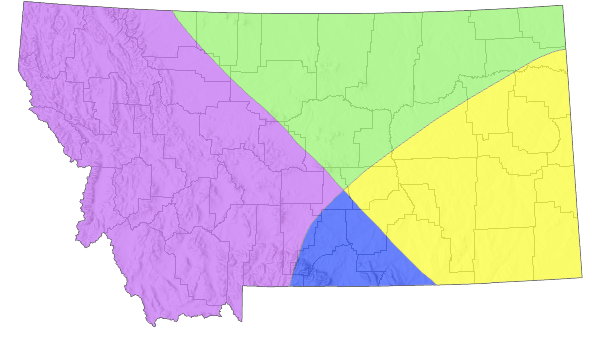 Western Hemisphere Range
Western Hemisphere Range
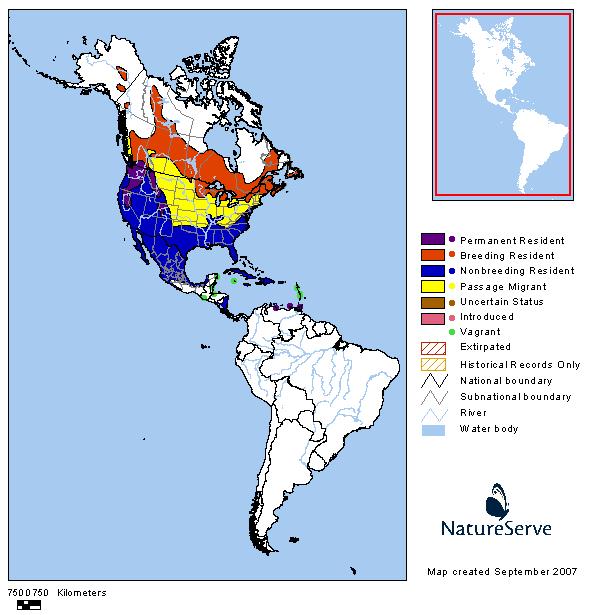
Observations in Montana Natural Heritage Program Database
Number of Observations: 9226
(Click on the following maps and charts to see full sized version)
Map Help and Descriptions
Relative Density
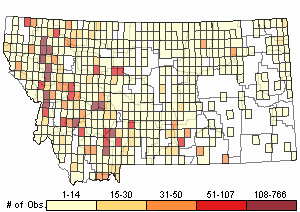
Recency
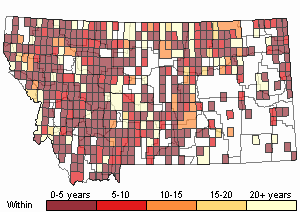
SUMMER (Feb 16 - Dec 14)
Direct Evidence of Breeding

Indirect Evidence of Breeding

No Evidence of Breeding

WINTER (Dec 15 - Feb 15)
Regularly Observed

Not Regularly Observed

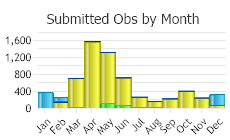
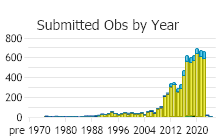
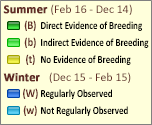 (Observations spanning multiple months or years are excluded from time charts)
(Observations spanning multiple months or years are excluded from time charts)
Migration
The normal migration periods in the Bozeman area are from April 15 to May 20 and from September 15 to November 1, with peak numbers on May 1 and October 10.
Habitat
Freshwater wetlands, especially marshes, fens, and bogs that are generally shallow with fringes of flooded or floating emergents, predominantly sedges interspersed with other vegetation and shrubs; also open water zones vegetated with abundant submerged or floating aquatic plants (Hohman and Eberhardt 1998). In the Bozeman area, habitat is restricted to lakes and ponds.
National Vegetation Classification System Groups Associated with this Species
Forest and Woodland
Deciduous Forest and Woodland
Wetland and Riparian
Alkaline - Saline Wetlands
Alpine Riparian and Wetland
Peatland
Riparian and Wetland Forest
Riparian Shrubland
Wet Meadow and Marsh
Food Habits
Moist-soil and aquatic plant seeds and tubers; aquatic invertebrates (Hohman and Eberhardt 1998).
Ecology
In the Fortine area, the population is increasing. The first young in the area were seen in 1970.
Reproductive Characteristics
Constructs nest over water in dense emergent vegetation. Eggs are elliptical to oval in shape and olive gray to olive brown in color (Hohman and Eberhardt 1998). Brood records for Montana and Wyoming are reported from June 9 to July 28. Hatching dates in the Fortine area are from June 20 to July 15. Brood size averaged 6.
Stewardship Responsibility
References
- Literature Cited AboveLegend:
 View Online Publication
View Online Publication Hohman, H. L., and R. T. Eberhardt. 1998. Ring-necked Duck (Aythya collaris). In The birds of North America, No. 329 (A. Poole and F. Gill, Eds.). Academy of Natural Sciences of Philadelphia and American Ornithologists’ Union. [Revised online 24 September 2012]
Hohman, H. L., and R. T. Eberhardt. 1998. Ring-necked Duck (Aythya collaris). In The birds of North America, No. 329 (A. Poole and F. Gill, Eds.). Academy of Natural Sciences of Philadelphia and American Ornithologists’ Union. [Revised online 24 September 2012] Marks, J.S., P. Hendricks, and D. Casey. 2016. Birds of Montana. Arrington, VA. Buteo Books. 659 pages.
Marks, J.S., P. Hendricks, and D. Casey. 2016. Birds of Montana. Arrington, VA. Buteo Books. 659 pages.
- Additional ReferencesLegend:
 View Online Publication
View Online Publication
Do you know of a citation we're missing? [WWPC] Washington Water Power Company. 1995. 1994 wildlife report Noxon Rapids and Cabinet Gorge Reservoirs. Washington Water Power Company. Spokane, WA.
[WWPC] Washington Water Power Company. 1995. 1994 wildlife report Noxon Rapids and Cabinet Gorge Reservoirs. Washington Water Power Company. Spokane, WA. American Ornithologists’ Union [AOU]. 1998. Check-list of North American birds, 7th edition. American Ornithologists’ Union, Washington, D.C. 829 p.
American Ornithologists’ Union [AOU]. 1998. Check-list of North American birds, 7th edition. American Ornithologists’ Union, Washington, D.C. 829 p. Cornely, J.E., C.L. Foster, M.A. Stern and R.S. Johnstone. 1981. Additional record of Ring-necked Duck nesting at Malheur National Wildlife Refuge, Oregon. The Murrelet, Summer 1981. pp. 55-56.
Cornely, J.E., C.L. Foster, M.A. Stern and R.S. Johnstone. 1981. Additional record of Ring-necked Duck nesting at Malheur National Wildlife Refuge, Oregon. The Murrelet, Summer 1981. pp. 55-56. Dickson, D.C. 1991. Systematic wildlife observations on the Blackfoot-Clearwater Wildlife Management Area. Montana Department of Fish, Wildlife and Parks. Missoula, MT. 14 pp. plus appendices and photographs.
Dickson, D.C. 1991. Systematic wildlife observations on the Blackfoot-Clearwater Wildlife Management Area. Montana Department of Fish, Wildlife and Parks. Missoula, MT. 14 pp. plus appendices and photographs. ECON, Inc. (Ecological Consulting Service), Helena, MT., 1977, Colstrip 10 x 20 Area wildlife and wildlife habitat annual monitoring report, 1977. Proj. 164-85-A. December 31, 1977.
ECON, Inc. (Ecological Consulting Service), Helena, MT., 1977, Colstrip 10 x 20 Area wildlife and wildlife habitat annual monitoring report, 1977. Proj. 164-85-A. December 31, 1977. ECON, Inc. (Ecological Consulting Service), Helena, MT., 1979, Annual wildllife report of the Colstrip Area for 1979, including a special raptor research study. Proj. 216-85-A. March 1, 1980.
ECON, Inc. (Ecological Consulting Service), Helena, MT., 1979, Annual wildllife report of the Colstrip Area for 1979, including a special raptor research study. Proj. 216-85-A. March 1, 1980. Ehrlich, P., D. Dobkin, and D. Wheye. 1988. The birder’s handbook: a field guide to the natural history of North American birds. Simon and Schuster Inc. New York. 785 pp.
Ehrlich, P., D. Dobkin, and D. Wheye. 1988. The birder’s handbook: a field guide to the natural history of North American birds. Simon and Schuster Inc. New York. 785 pp. Gjersing, F.M. 1975. Waterfowl production in relation to rest-rotation grazing. Journal of Range Management 28:37-42.
Gjersing, F.M. 1975. Waterfowl production in relation to rest-rotation grazing. Journal of Range Management 28:37-42. Gniadek, S. 1983. Southwest Glendive Wildlife Baseline Inventory. Miles City, Mont: Bureau of Land Management, Miles City District Office. 56 pp with appendices.
Gniadek, S. 1983. Southwest Glendive Wildlife Baseline Inventory. Miles City, Mont: Bureau of Land Management, Miles City District Office. 56 pp with appendices. Golden Sunlight Mines, Inc. 2000. Golden Sunlight Mines, Inc., Whitehall, MT. Annual Permit Reports.
Golden Sunlight Mines, Inc. 2000. Golden Sunlight Mines, Inc., Whitehall, MT. Annual Permit Reports. Goodell, J. 2012. Morse Land Company Breeding Bird Inventory And Analysis. High Desert Museum. Bend, OR. 42 pp + Appendices.
Goodell, J. 2012. Morse Land Company Breeding Bird Inventory And Analysis. High Desert Museum. Bend, OR. 42 pp + Appendices. Hays, R., R.L. Eng, and C.V. Davis (preparers). 1984. A list of Montana birds. Helena, MT: MT Dept. of Fish, Wildlife & Parks.
Hays, R., R.L. Eng, and C.V. Davis (preparers). 1984. A list of Montana birds. Helena, MT: MT Dept. of Fish, Wildlife & Parks. Johnsgard, P.A. 1975. Waterfowl of North America. Bloomington, IN: Indiana University Press. 575 p.
Johnsgard, P.A. 1975. Waterfowl of North America. Bloomington, IN: Indiana University Press. 575 p. Johnsgard, P.A. 1979. Birds of the Great Plains: breeding species and their distribution. University of Nebraska Press, Lincoln. 539 pp.
Johnsgard, P.A. 1979. Birds of the Great Plains: breeding species and their distribution. University of Nebraska Press, Lincoln. 539 pp. Johnsgard, P.A. 1992. Birds of the Rocky Mountains with particular reference to national parks in the northern Rocky Mountain region. Lincoln: University of Nebraska Press. xi + 504 pp.
Johnsgard, P.A. 1992. Birds of the Rocky Mountains with particular reference to national parks in the northern Rocky Mountain region. Lincoln: University of Nebraska Press. xi + 504 pp. Joslin, Gayle, and Heidi B. Youmans. 1999. Effects of recreation on Rocky Mountain wildlife: a review for Montana. [Montana]: Montana Chapter of the Wildlife Society.
Joslin, Gayle, and Heidi B. Youmans. 1999. Effects of recreation on Rocky Mountain wildlife: a review for Montana. [Montana]: Montana Chapter of the Wildlife Society. Korschgen, C.E., and R.B. Dahlgren. 1992. Human disturbances of waterfowl: causes, effects, and management. Ch. 13.2.15 In: Waterfowl Management Handbook. Fish and Wildlife Service Leaflet. 8 p.
Korschgen, C.E., and R.B. Dahlgren. 1992. Human disturbances of waterfowl: causes, effects, and management. Ch. 13.2.15 In: Waterfowl Management Handbook. Fish and Wildlife Service Leaflet. 8 p. Land & Water Consulting, Inc. 2002. Montana Dept. of Transportation Wetland Mitigation Monitoring Report. Year 2001: Creston Site, Creston, Montana. Project No. 130091.007. July 2002. In 2001 Wetland Mitigation Monitoring Reports, Vol. I.
Land & Water Consulting, Inc. 2002. Montana Dept. of Transportation Wetland Mitigation Monitoring Report. Year 2001: Creston Site, Creston, Montana. Project No. 130091.007. July 2002. In 2001 Wetland Mitigation Monitoring Reports, Vol. I. Lenard, S., J. Carlson, J. Ellis, C. Jones, and C. Tilly. 2003. P. D. Skaar's Montana bird distribution, 6th edition. Montana Audubon, Helena, MT. 144 pp.
Lenard, S., J. Carlson, J. Ellis, C. Jones, and C. Tilly. 2003. P. D. Skaar's Montana bird distribution, 6th edition. Montana Audubon, Helena, MT. 144 pp. Lorang, K.D. 1979. Waterfowl and hunter use of Freezeout Lake Game Management Area. M.Sc. Thesis. Bozeman, Montana: Montana State University. 79 p.
Lorang, K.D. 1979. Waterfowl and hunter use of Freezeout Lake Game Management Area. M.Sc. Thesis. Bozeman, Montana: Montana State University. 79 p. Matthews, W.L. 1981. Broadus-Pumpkin Creek baseline inventory - wildlife. Bureau of Land Management, Miles City, MT. 83 p.
Matthews, W.L. 1981. Broadus-Pumpkin Creek baseline inventory - wildlife. Bureau of Land Management, Miles City, MT. 83 p. Maxon, S.J. and M.R. Riggs. 1996. Habitat use and nest success of overwater nesting ducks in westcentral Minnesota. J. Wildl. Manage. 60(1): 108-119.
Maxon, S.J. and M.R. Riggs. 1996. Habitat use and nest success of overwater nesting ducks in westcentral Minnesota. J. Wildl. Manage. 60(1): 108-119. Merendino, M.T., G.B. McCullough, and N.R. North. 1995. Wetland availability and use by breeding waterfowl in southern Ontario. J. Wildl. Manage. 59(3): 527-532.
Merendino, M.T., G.B. McCullough, and N.R. North. 1995. Wetland availability and use by breeding waterfowl in southern Ontario. J. Wildl. Manage. 59(3): 527-532. Montana Bird Distribution Committee. 2012. P.D. Skaar's Montana bird distribution. 7th Edition. Montana Audubon, Helena, Montana. 208 pp. + foldout map.
Montana Bird Distribution Committee. 2012. P.D. Skaar's Montana bird distribution. 7th Edition. Montana Audubon, Helena, Montana. 208 pp. + foldout map. MT Fish, Wildlife & Parks. No date. Blackfoot-Clearwater Wildlife Management Area checklist.
MT Fish, Wildlife & Parks. No date. Blackfoot-Clearwater Wildlife Management Area checklist. Munshower, Frank F., 1974, Animal tissue collections and bone fluoride concentrations at Colstrip, MT. 1973. Collecting Report, 1973. January 1974.
Munshower, Frank F., 1974, Animal tissue collections and bone fluoride concentrations at Colstrip, MT. 1973. Collecting Report, 1973. January 1974. Oechsli, L.M. 2000. Ex-urban development in the Rocky Mountain West: consequences for native vegetation, wildlife diversity, and land-use planning in Big Sky, Montana. M.Sc. Thesis. Montana State University, Bozeman. 73 p.
Oechsli, L.M. 2000. Ex-urban development in the Rocky Mountain West: consequences for native vegetation, wildlife diversity, and land-use planning in Big Sky, Montana. M.Sc. Thesis. Montana State University, Bozeman. 73 p. Palmer, R.S. 1962. Handbook of North American birds. Volume 1. Loons through flamingos. Yale University Press, New Haven. 567 pp.
Palmer, R.S. 1962. Handbook of North American birds. Volume 1. Loons through flamingos. Yale University Press, New Haven. 567 pp. Rhodes, O.E., Jr., L.M. Smith and M.H. Smith. 1991. Conservation and genetic resources in waterfowl. Trans. N. Amer. Wildl. & Nat. Res. Conf. 56:462-472.
Rhodes, O.E., Jr., L.M. Smith and M.H. Smith. 1991. Conservation and genetic resources in waterfowl. Trans. N. Amer. Wildl. & Nat. Res. Conf. 56:462-472. Rundquist, V.M. 1973. Avian ecology on stock ponds in two vegetational types in north-central Montana. Ph.D. Dissertation. Bozeman, MT: Montana State University. 112 p.
Rundquist, V.M. 1973. Avian ecology on stock ponds in two vegetational types in north-central Montana. Ph.D. Dissertation. Bozeman, MT: Montana State University. 112 p. Sibley, D. 2014. The Sibley guide to birds. Alfred A. Knopf, New York, NY. 598 pp.
Sibley, D. 2014. The Sibley guide to birds. Alfred A. Knopf, New York, NY. 598 pp. Skaar, P. D., D. L. Flath, and L. S. Thompson. 1985. Montana bird distribution. Montana Academy of Sciences Monograph 3(44): ii-69.
Skaar, P. D., D. L. Flath, and L. S. Thompson. 1985. Montana bird distribution. Montana Academy of Sciences Monograph 3(44): ii-69. Skaar, P.D. 1969. Birds of the Bozeman latilong: a compilation of data concerning the birds which occur between 45 and 46 N. latitude and 111 and 112 W. longitude, with current lists for Idaho, Montana, Wyoming, impinging Montana counties and Yellowstone National Park. Bozeman, MT. 132 p.
Skaar, P.D. 1969. Birds of the Bozeman latilong: a compilation of data concerning the birds which occur between 45 and 46 N. latitude and 111 and 112 W. longitude, with current lists for Idaho, Montana, Wyoming, impinging Montana counties and Yellowstone National Park. Bozeman, MT. 132 p. Stewart, R.E. and H.A. Kantrud. 1972. Population estimates of breeding birds in North Dakota. The Auk 89(4):766-788.
Stewart, R.E. and H.A. Kantrud. 1972. Population estimates of breeding birds in North Dakota. The Auk 89(4):766-788. Swan River National Wildlife Refuge. 1982. Birds of the Swan River NWR. Kalispell, MT: NW MT Fish and Wildlife Center pamphlet.
Swan River National Wildlife Refuge. 1982. Birds of the Swan River NWR. Kalispell, MT: NW MT Fish and Wildlife Center pamphlet. Thompson, L.S. 1981. Circle West wildlife monitoring study: Third annual report. Technical report No. 8. Montana Department of Natural Resources and Conservation. Helena, Montana.
Thompson, L.S. 1981. Circle West wildlife monitoring study: Third annual report. Technical report No. 8. Montana Department of Natural Resources and Conservation. Helena, Montana. U.S. Forest Service. 1991. Forest and rangeland birds of the United States: Natural history and habitat use. U.S. Department of Agriculture, Forest Service Agricultural Handbook 688. 625 pages.
U.S. Forest Service. 1991. Forest and rangeland birds of the United States: Natural history and habitat use. U.S. Department of Agriculture, Forest Service Agricultural Handbook 688. 625 pages. Waldt, R. 1995. The Pine Butte Swamp Preserve bird list. Choteau, MT: The Nature Conservancy. Updated August 1995.
Waldt, R. 1995. The Pine Butte Swamp Preserve bird list. Choteau, MT: The Nature Conservancy. Updated August 1995. Watts, C.R. and L.C. Eichhorn. 1981. Changes in the birds of central Montana. Proceedings of the Montana Academy of Sciences 40:31-40.
Watts, C.R. and L.C. Eichhorn. 1981. Changes in the birds of central Montana. Proceedings of the Montana Academy of Sciences 40:31-40. Western Technology and Engineering, Inc. (WESTECH). 1994. Wildlife Monitoring Absaloka Mine Area Annual Report, 1993. Montana SMP 85005. OSMP Montana 0007c. Mar. 12, 1994.
Western Technology and Engineering, Inc. (WESTECH). 1994. Wildlife Monitoring Absaloka Mine Area Annual Report, 1993. Montana SMP 85005. OSMP Montana 0007c. Mar. 12, 1994. Western Technology and Engineering, Inc. (WESTECH)., 2001, Wildlife Monitoring Absaloka Mine Area Annual Report, 2000. Montana SMP 85005. OSMP Montana 0007E. February 2001.
Western Technology and Engineering, Inc. (WESTECH)., 2001, Wildlife Monitoring Absaloka Mine Area Annual Report, 2000. Montana SMP 85005. OSMP Montana 0007E. February 2001.
- Web Search Engines for Articles on "Ring-necked Duck"
- Additional Sources of Information Related to "Birds"





